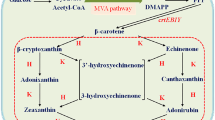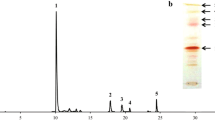Abstract
A complementation analysis was performed in Escherichia coli to evaluate the efficiency of β-carotene ketolases (CrtW) from the marine bacteria Brevundimonas sp. SD212, Paracoccus sp. PC1 (Alcaligenes PC-1), and Paracoccus sp. N81106 (Agrobacterium aurantiacum), for astaxanthin production. Each crtW gene was expressed in Escherichia coli synthesizing zeaxanthin due to the presence of plasmid pACCAR25ΔcrtX. Carotenoids that accumulated in the resulting E. coli transformants were examined by chromatographic and spectroscopic analyses. The transformant carrying the Paracoccus sp. PC1 or N81106 crtW gene accumulated high levels of adonixanthin, which is the final astaxanthin precursor for CrtW, and astaxanthin, while the E. coli transformant with crtW from Brevundimonas sp. SD212 did not accumulate any adonixanthin and produced a high level of astaxanthin. These results show efficient conversion by CrtW of Brevundimonas sp. SD212 from adonixanthin to astaxanthin, which is a new-found characteristic of a bacterial CrtW enzyme. The phylogenetic positions between CrtW of the two genera, Brevundimonas and Paracoccus, are distant, although they fall into α-Proteobacteria.





Similar content being viewed by others
References
Altschul SF, Madden TL, Schaffer AA, Zhang J, Zhang Z, Miller W, Lipmann DJ, (1997). Gapped BLAST and PSI-BLAST: a new generation of protein database search programs Nucleic Acids Res 25: 3389–3402
Andrewes AG, Phaff HJ, Starr MP, (1976). Carotenoids of Phaffia rhodozyma, a red-pigmented fermenting yeast Phytochemistry 15: 1003–1007
Berry A, Janssens D, Humbelin M, Jore JPM, Hoste B, Cleenwerck L, Vancanneyt M, Bretzel W, Mayer AF, Lopez-Ulibarri R, Shanmugam B, Swings J, Pasamontes L, (2003). Paracoccus zeaxanthinifaciens sp. nov., a zeaxanthin-producing bacterium Int J System Evol Micr 53: 231–238
Boussiba S, Vonshak A, (1991). Astaxanthin accumulation in the green alga Haematococcus pluvialis Plant Cell Physiol 32: 1077–1082
Chen BP, Park JS, (2004). Carotenoid action on the immune response Nutr 134: 257S–261S
Chen BP, Park JS, Wong MW, Wong TS, (1999). A comparision of the anticancer activities of dietary beta-carotene, canthaxanthin and astaxanthin in mice in vivo Anticancer Res 19: 1849–1853
Felsenstein J (1985). Confidence limits on phylogenies: an approach using the bootstrap. Evolution 39: 783–791
Fraser PD, Miura Y, Misawa N (1997). In vitro characterization of astaxanthin biosynthetic enzymes J Biol Chem 272: 6128–6135
Gotz T, Sandmann G, Romer S (2002). Expression of a bacterial carotene hydroxylase gene (crtZ) enhances UV tolerance in tobacco Plant Mol Biol 50: 129–142
Hannibal L, Lorquin J, D’Ortoli NA, Garcia N, Chaintreuil C, Masson-Boivin C, Dreyfus B, Giraud E (2000). Isolation and characterization of the canthaxanthin biosynthesis genes from the photosynthetic bacterium Bradyrhizobium sp. strain ORS278 J Bacteriol 182: 3850–3853
Iwamoto T, Hosoda K, Hirano R, Kurata H, Matsumoto A, Miki W, Kamiyama M, Itakura H, Yamamoto S, Kondo K (2000). Inhibition of low-density lipoprotein oxidation by astaxanthin J Atheroscler Thromb 7: 216–222
Kimura M (1980). A simple method for estimating evolutionary rates of base substitutions through comparative studies of nucleotide sequences J Mol Evol 16: 111–120
Lorenz RT, Cysewski GR (2000). Commercial potential for Haematococcus microalgae as a natural source of astaxanthin Trends Biotechnol 18: 160–167
Mann V, Harker M, Pecker L, Hirschberg J (2000). Metabolic engineering of astaxanthin production in tobacco flowers Nat Biotechnol 18: 888–892
Masamoto K, Misawa N, Kaneko T, Kikuno R, Toh H (1998). β-Carotene hydroxylase gene from the cyanobacterium Synechocystis sp. PCC6803. Plant Cell Physiol 39: 560–564
Miki W, Yamaguchi K, Konosu S (1982). Comparison of carotenoids in the ovaries of marine fish and shellfisn Comp Biochem Physiol 71B: 7–11
Misawa N, Satomi Y, Kondo K, Yokoyama A, Kajiwara S, Saito T, Ohtani T, Miki W (1995). Structure and functional analysis of a marine bacterial carotenoid biosynthesis gene cluster and astaxanthin biosynthetic pathway proposed at the gene level J Bacteriol 177: 6575–6584
Miura Y, Kondo K, Saito T, Shimada H, Fraser PD, Misawa N (1998). Production of the carotenoids lycopene, β -carotene, and astaxanthin in the food yeast Candida utilis Appl Environ Microbiol 64: 1226–1229
Ralley L, Enfissi EM, Misawa N, Schuch W, Bramley PM, Fraser PD (2004). Metabolic engineering of ketocarotenoid formation in higher plants Plant J 39: 477–486
Romer S, Fraser PD, Kiano JW, Shipton CA, Misawa N, Schuch W, Bramley PM (2000). Elevation of the provitamin A content of transgenic tomato plants Nat Biotechnol 18: 666–669
Saitou N, Nei M (1987). The neighbor-joining method: a new method for reconstructing phylogenetic trees Mol Biol Evol 4: 406–425
Sambrook J, Fritsch EF, Maniatis T (1989) Molecular Cloning: A Laboratory maual, 2nd ed. (Cold Spring Harbor, Ny: Cold Spring Harbor Laboratory press)
Shewmaker CK, Sheehy JA, Daley M, Colburn S, Ke DY (1999). Seed-specific overexpression of phytoene synthase: increase in carotenoids and other metabolic effects Plant 720: 401–412
Steiger S, Sandmann G (2004). Cloning of two carotenid ketolase genes from Nostoc punctiforme for the heterologous production of canthaxanthin and astaxanthin Biotechnol Lett 26: 813–817
Tanaka T, Morishita Y, Suzui M, Kojima T, Okumura A, Mori H (1994). Chemoprevention of mouse urinary bladder carcinogenesis by the naturally occurring carotenoid astaxanthin Carcinogenesis 15: 15–19
Tatsuzawa H, Maruyama T, Misawa N, Fujimori K, Nakano M (2000). Quenching of singlet oxygen by carotenoids produced in Escherichia coli–attenuation of singlet oxygen–mediated bacterial killing by carotenoids FEES Lett 484: 280–284
Thompson JD, Gibson TJ, Plewniak F, Jeanmougin F, Higgins DG (1997). The CLUSTAL X Windows interface: flexible strategies for multiple sequence alignment aided by quality analysis tools Nucleic Acids Res 24: 4876–4882
Wang CW, Oh MK, Liao JC (1999). Engineered isoprenoid pathway enhances astaxanthin production in Escherichia coli Biotechnol Bioeng 62: 235–241
Ye X, Al-Babili S, Kloti A, Zhang J, Lucca P, Beyer P, Potrykus I (2000). Engineering the provitamin A (beta-carotene) biosynthetic pathway into (carotenoid-free) rice endosperm Science 287: 303–305
Yokoyama A, Miki W (1995). Composition and presumed biosynthetic pathway of carotenoids in the astaxanthin-producing bacterium Agrobacterium aurantiacum FEMS Microbial Lett 128: 139–144
Yokoyama A, Miki W, Izumida H, Shizuri Y (1996). New trihydroxy-keto-carotenoids isolated from an astaxanthin-producing marine bacterium Biosci Biotech Biochem 60: 200–203
Yokoyama A, Izumida H, Miki W (1994). Production of astaxanthin and 4-ketoxanthin by the marine bacterium, Agrobacterium aurantiacum Biosci Biotech Biochem 58: 1842–1844
Acknowledgments
We thank Seiko Tateshita for her technical contribution. This work was supported by Biotechnology and Medical Technology Development Department of New Energy and Industrial Technology Development Organization (NEDO).
Author information
Authors and Affiliations
Corresponding author
Rights and permissions
About this article
Cite this article
Choi, Sk., Nishida, Y., Matsuda, S. et al. Characterization of β -Carotene Ketolases, CrtW, from Marine Bacteria by Complementation Analysis in Escherichia coli. Mar Biotechnol 7, 515–522 (2005). https://doi.org/10.1007/s10126-004-5100-z
Received:
Accepted:
Published:
Issue Date:
DOI: https://doi.org/10.1007/s10126-004-5100-z




